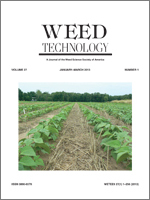Methyl bromide (MBr) has been an industry standard for soil fumigation in a multitude of crops for decades. However, it has been banned by the United Nations Environment Programme, and alternatives to MBr must be implemented to sustain productivity in many vegetable crops that depend on soil fumigation. One alternative that has been implemented in some areas is methyl iodide (MeI). Efficacy of MeI has been demonstrated on many pest species and has been generally similar to MBr. Methyl iodide is a costly material, which has likely limited its adoption. Virtually impermeable film (VIF) and totally impermeable film (TIF) provide greater fumigant retention than low-density and high-density polyethylene film, which can allow for reduced fumigant application rates while maintaining fumigant efficacy. The objectives of this research were to evaluate TIF with reduced rates of shank-applied MeI : chloropicrin (Pic) (50 : 50 w/w) for the control of yellow nutsedge in tomato. Treatments included a standard rate of MeI : Pic (93.3 L ha−1 [178 kg ha−1 broadcast]) under VIF and TIF, three reduced rates (37.3, 56, 74.6 L ha−1 [71.2, 106.8, 142.5 kg ha−1 broadcast, respectively]) under TIF, and a nontreated control under TIF. Results indicate fumigant use rates may be reduced from a standard 93.3 L ha−1 under VIF to 37.3 L ha−1 (60% reduction) under TIF while providing yellow nutsedge control and maintaining tomato yields.
Nomenclature: Methyl iodide; chloropicrin; yellow nutsedge, Cyperus esculentus L.; tomato, Solanum lycopersicum L.
Methyl bromide (MBr) ha sido el estándar de la industria para la fumigación de suelo en múltiples cultivos por décadas. Sin embargo, debido a que ha sido prohibido por el Programa para el Ambiente de las Naciones Unidas, alternativas a MBr deben ser implementadas para mantener la productividad de muchos vegetales que dependen de la fumigación del suelo. Una alternativa que ha sido implementada en varias áreas es methyl iodide (MeI). La eficacia de MeI ha sido demostrada en muchas especies de plagas y ha sido generalmente similar a MBr. Methyl iodide es un material costoso, lo que probablemente ha limitado su adopción. Coberturas virtualmente impermeables (VIF) y coberturas totalmente impermeables (TIF) brindan mayor retención del fumigante que las coberturas de polyethylene de baja o alta densidad, lo que permite el uso de dosis reducidas de fumigante manteniendo su eficacia. Los objetivos de esta investigación fueron evaluar TIF con dosis reducidas inyectadas al suelo de MeI:chloropicrin (Pic) (50:50 w/w) para el control de Cyperus esculentus en tomate. Los tratamientos incluyeron una dosis estándar de MeI:Pic (93.3 L ha−1 [178 kg ha−1 aplicación generalizada]) bajo VIF y TIF, tres dosis reducidas (37.3, 56, 74.6 L ha−1 [71.2, 106.8, 142. 5 kg ha−1 aplicación generalizada, respectivamente]) bajo TIF y un testigo no tratado bajo TIF. Los resultados indican que las dosis de fumigante pueden ser reducidas desde el estándar 93.3 L ha−1 bajo VIF a 37.3 L ha−1 (reducción del 60%) bajo TIF al tiempo que se obtiene el control de C. esculentus y se mantiene el rendimiento del tomate.





